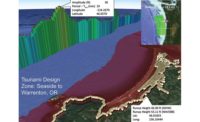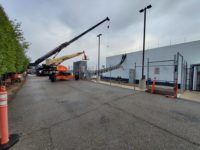With its ability to create shallow waves of great length in a laboratory flume, a new tsunami simulator in the U.K. is helping seismic engineers at University College’s EPICentre, London, compute more accurate structural impact models than previously were possible.
Led by professor Tiziana Rossetto, the team aims to provide more realistic predictions of tsunami damage to building clusters. By first modeling clusters, it hopes the results may more easily be extended to urban scale to aid disaster management and improve design of critical infrastructure and coastal defences.
Key to the work is a pneumatically powered wave tank at Oxfordshire-based HR Wallingford Ltd. By improving the modeling of earthquake-spawned tsunami, including the crest-led waves from the upthrust side of the earthquake fault that strike first as giant breakers as well as the trough-led tsunami that propagate from the dropped side and show up first as dropping sea level, the facility simulates, for the first time, realistic impacts on urban areas, say the engineers. In the 2004 Indian Ocean tsunami, a crest-led tsunami hit Thailand and a trough-led tsunami hit Sri Lanka.
“It was the 2004 Indian Ocean tsunami that inspired this work,” says Rossetto. She says she had difficulty estimating tsunami forces because data is scarce on extremely long waves with relatively low amplitudes; further, the physics is not fully understood. “This is particularly true with their impact on onshore structures,” notes Rossetto.
Then, Rossetto met the HR Wallingford team, which revised its design of a pneumatic device made for tidal modeling in the 1950s, says project engineer Ian Chandler. The modified facility can send a wave that is 700 meters long through its 70-m-long by 4-m-wide flume, he says.
Traditional simulators can generate only relatively short wavelengths because they use pistons to drive the water, so wavelengths are constrained by the length of the piston stroke. Newer piston generators are increasing wave lengths, but none come close to the pneumatic setup, says Chandler. Adds Rossetto, “We found from our studies that the physics of those shorter waves is very different.”
A government grant nine years ago funded the first tsunami simulator program and the formation of EPICentre. A subsequent $2.1 million from the European Union paid for the current, improved device.
Among other tests, during the 2004 Indian Ocean event, the engineers used water-depth data recorded off the coast of Thailand to simulate, at 1:50 vertical scale, a tsunami in 2.5 minutes that actually lasted 20 minutes. By operating at larger dimensions and longer time periods than previously possible, the influence of non-scalable factors, such as water surface tension, is reduced, says Chandler.
So far, tests show that buildings in clusters experience different forces from buildings in isolation. “Clusters … actually change the loading,” Rosetto says. “It’s only by looking at these phenomena in [this] flume that we are seeing this. It wouldn’t be true of a short wave.”







Post a comment to this article
Report Abusive Comment